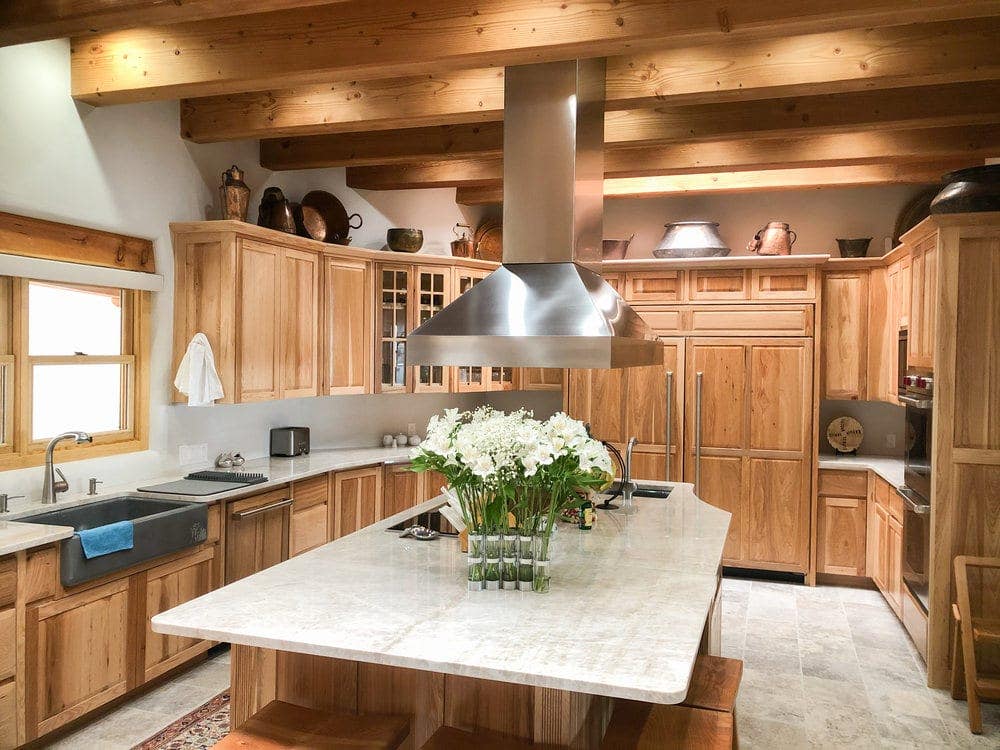Installing a range hood vent through the ceiling may seem like a daunting task, but it is actually quite simple. The most important thing to remember is to take your time and follow the instructions carefully. Here are the basic steps to install a range hood vent through the ceiling:
1. Choose the location for your range hood vent. You will need to have access to both the underside of your kitchen cabinets and the space above your ceiling.
2. Cut a hole in the bottom of your cabinets that is large enough for the ductwork of your range hood vent.
3. Connect the ductwork of your range hood vent to the exhaust port on your stove or cooktop. Make sure that all connections are tight and secure.
4. Run the ductwork up through the hole you cut in Step 2, and then through the hole in your ceiling.
Attach it securely to any support beams or joists in order to prevent it from sagging over time.
- Cut a hole in the ceiling that is slightly smaller than the range hood vent using a drywall saw
- Place the range hood vent over the hole and secure it in place with screws
- Connect the ductwork to the range hood vent and seal any gaps with caulk or foil tape
- Turn on the power to the range hood vent and test it to make sure it is working properly
Ducting Range Hood Vent to Roof
How Do You Vent a Range Hood to the Ceiling?
If you’re looking to vent your range hood to the ceiling, there are a few things you’ll need to take into account. First, you’ll need to make sure that your range hood is the right size for your stove. You don’t want a range hood that’s too small or too big – it won’t work as effectively and could end up costing you more in energy bills.
Next, you’ll need to determine where the best place to vent the hood would be. You’ll want to avoid any potential obstacles like cabinets or beams. Once you’ve found the perfect spot, mark it off so you know where to drill your holes.
Now it’s time to get started on drilling! You’ll want two holes – one for the exhaust duct and one for the power cord. Make sure that both holes are slightly bigger than what they need to be so there’s no chance of them being too small.
Finally, it’s time to install your range hood. Start by running the power cord through one of the holes and connecting it to an outlet. Then, attach the exhaust ducting to the other hole and run it up through the ceiling until it reaches outside.
Once everything is connected, turn on your range hood and test it out!
Is It Better to Vent Range Hood Through Wall Or Roof?
If you are looking to vent your range hood, you may be wondering if it is better to do so through the wall or roof. There are pros and cons to both methods, so it is important to weigh your options before making a decision.
One benefit of venting through the wall is that it is typically easier to install than venting through the roof.
Additionally, wall vents tend to be less expensive than roof vents. However, there are some downsides to this method as well. For example, if your kitchen is located on an exterior wall, you will need to worry about weatherproofing the vent in order to prevent drafts and moisture from coming into your home.
Additionally, wall vents can be more visible than roof vents, so they may not be ideal if you are hoping for a discreet installation.
Venting through the roof has its own set of advantages and disadvantages. One advantage is that it tends to provide better ventilation since hot air rises.
Roof vents also tend to be more durable than wall vents since they are less likely to be damaged by wind or rain. However, installing a roof vent can be more challenging than installing a wall vent, so you may need to hire a professional if you aren’t comfortable doing it yourself. Additionally, depending on the pitch of your roof, snow and debris could collect on top of the vent cover, which would then need to be cleared away periodically.
Can a Range Hood Be Vented Through the Roof?
A range hood can be vented through the roof if it is the proper size and has the correct type of venting material. The range hood must be sized correctly so that it does not put too much pressure on the roof or cause problems with the ventilation system. The type of venting material will also determine whether or not a range hood can be vented through the roof.
Some materials, such as metal, may cause problems because they are not able to handle the high temperatures that are produced by a range hood.
Does a Range Hood Need to Be Vented Outside?
Most range hoods on the market today are vented. A vented range hood is necessary to remove heat, fumes, and smoke from cooking. The blower in the range hood forces air out through a duct to the outside of your home.
This type of range hood is more effective at removing grease and odors than a non-vented range hood because it does not recirculate air back into the kitchen.
There are some circumstances where a non-vented range hood may be used. If you have an electric stovetop, there are no fumes or smoke to remove so a non-ventedrange hood may be sufficient.
Non-ventedrange hoods are also less expensive than their vented counterparts. However, they are not as effective at removing grease and odors and should only be used in kitchens with good ventilation.


Credit: homeinspectorsecrets.com
How to Install a Range Hood Vent Through the Wall
Installing a range hood vent through the wall is a relatively easy job that most do-it-yourselfers can handle. The hardest part is usually getting the hole cut in the right spot and having it be level. Here are step-by-step instructions for installing a range hood vent through the wall:
1) Cut the Hole – Using a stud finder, locate two studs in the wall where you want to install the vent. mark these locations on both the inside and outside of the wall. Then, using a drill, create pilot holes at each of these marks.
Next, use a jigsaw to cut out a rectangular hole between your pilot holes (roughly 14”x3”). Be sure to wear safety goggles when cutting!
2) Install Vent Hood – Place the vent hood up against the outside of the house so that it covers the hole you just cut.
Trace around its outline with a pencil. Then, using screws and washers (included with your purchase), secure it to the siding.
3) Connect Ductwork – Measure and cut pieces of flexible ductwork to fit from your vent hood to an existing exhaust fan or opening in your attic space (or wherever else you’re routing it).
Secure these pieces together with foil tape or clamps (also included). Finally, attaching this ductwork to your vent hood following manufacturer’s instructions.
4) Install Vent Cover – On the inside of your home, placethevent cover overtheholeyoucutinthewall(make sureitfits snugly).
How to Install a Range Hood Vent Through Cabinet
If you’re looking to install a range hood vent through your cabinet, there are a few things you’ll need to keep in mind. First, make sure that the area where you’ll be cutting the opening for the vent is well-ventilated. Second, use a sharp knife or saw to cut through the cabinet material.
Be careful not to damage any of the surrounding surfaces.
Once you have the opening cut out, it’s time to install the range hood vent. Start by attaching the mounting bracket to the underside of the cabinet using screws or nails.
Then, fit the vent pipe into place and secure it with screws or clamps. Finally, connect the power supply and test out your new range hood vent!
How to Install a Range Hood Vent Through Attic
If you need to install a range hood vent and don’t want to go through the hassle of running ductwork through your home, then installing the vent through the attic is a great option. Here’s how to do it:
1. Start by finding a suitable location in the attic for the vent.
It should be close to where the range hood will be located, and there should be enough space around it for air to circulate freely.
2. Once you’ve found the perfect spot, mark out the area that will need to be cut out with a pencil or chalk.
3. Use a saw to cut out the opening for the vent.
Make sure that it’s large enough to accommodate the size of your range hood vent.
4. Install framing around the perimeter of the opening if necessary. This will provide support for the weight of the range hood vent.
5. Place your range hood vent into position and secure it with screws or bolts. Make sure that it’s level and plumb before tightening everything down too much.
6 .
Run ductwork from your range hood to this new opening in order to complete installation .
Conclusion
If you’re looking to install a range hood vent through your ceiling, here’s what you need to do. First, mark the center of the hood on the ceiling. Then, using a drill and a 1/4″ bit, make a hole in the center of the mark.
Next, insert a j-hook into the hole and screw it in place. Finally, attach the vent pipe to the j-hook and secure it with screws. That’s all there is to it!

